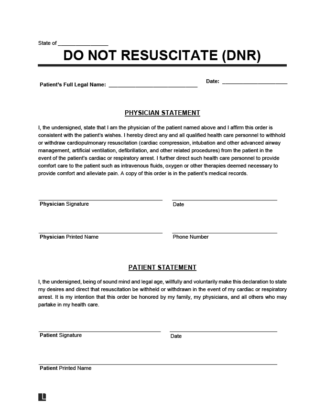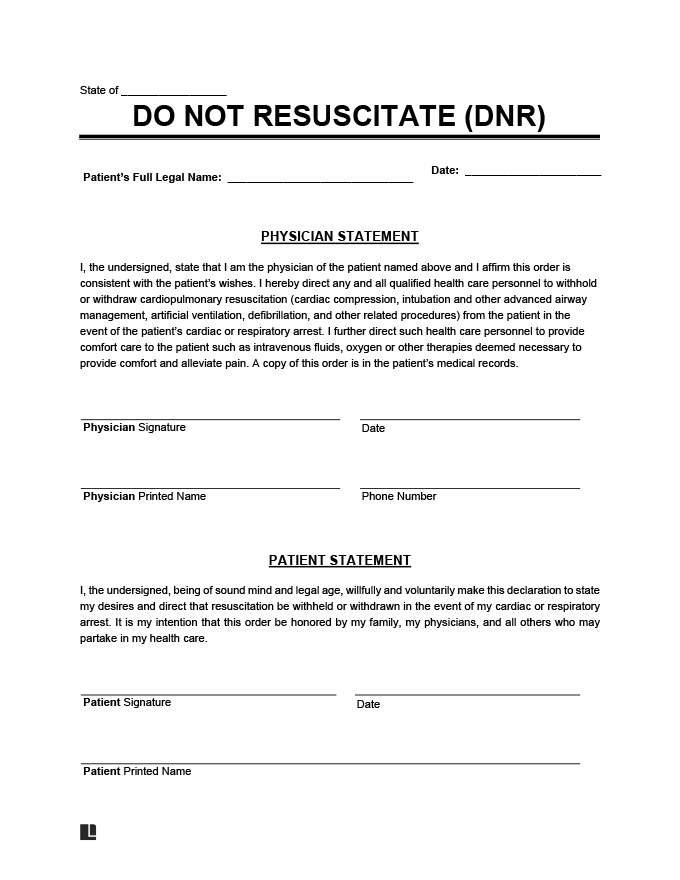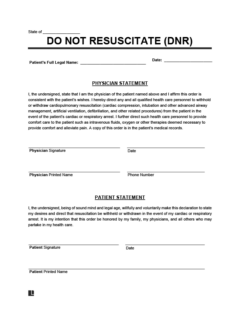
Use our DNR order if you don’t want cardiopulmonary resuscitation (CPR) when your heart stops.

Updated January 31, 2024
Written by Ioana Gagiuc | Reviewed by Brooke Davis
A do not resuscitate (DNR) order is used by individuals who do not want to be revived if their heart or breathing stops. It restricts emergency medical technicians or hospital personnel from attempting to save your life if you go into cardiac arrest or another life-threatening emergency.
DNR orders typically must be signed by your doctor, witnesses, and/or a notary public. You should familiarize yourself with your state’s do not resuscitate laws and signing requirements before you complete your form.
A DNR form is an end-of-life medical directive instructing healthcare professionals to withhold life-sustaining treatment at the patient’s request. It is used to prevent inappropriate administration of CPR, while all other treatments aimed at ensuring the individual’s comfort and pain relief will continue uninterrupted.
The laws regarding the withholding of resuscitation vary by state and typically mandate that the patient, along with their primary care physician, notary public, or witnesses, provide their signature on this form.
This protocol is frequently implemented in cases involving elderly individuals or those afflicted with conditions where a complete cure is not anticipated.
Do not resuscitate orders may be known by the following names, depending on your location:
In medical terms, “resuscitate” refers to the various procedures used by professionals in an emergency to revive a person from unconsciousness or the brink of death. In the case of a DNR order, however, “resuscitate” specifically refers to the use of cardiopulmonary resuscitation — commonly referred to as CPR.
As a reference, resuscitation methods may include:
A do not resuscitate form instructs physicians not to use any form of CPR (basic or advanced) should they become incapacitated and require a life-sustaining procedure.
A DNR order is put into effect when a person has a background of chronic disease or terminal illness, which has previously or might in the future require CPR, and that patient, due to concerns regarding the potential failure of CPR and the risk of sustaining brain damage or impairment, expresses their wish not to be resuscitated.
For anyone diagnosed with a painful or terminal condition, DNR orders can help avoid prolonged suffering. Choosing to withdraw resuscitation in the event of a cardiac or respiratory arrest does not mean palliative care will be withheld. That is to say, administering pain-relieving medication and comfort care will still be offered, should you desire.
Another essential factor to remember is the age when debating whether a DNR form suits you. Resuscitation is an intense and often traumatic medical procedure that elderly individuals may have trouble recovering from should it be successful.
Contrary to what some may think, signing a do not resuscitate order is not prohibited in the eyes of many religious institutions. Patients should consider their ethics and religious values before authorizing any end-of-life planning documentation.
Failing to follow a DNR order may lead to unwanted medical interventions that contradict the patient’s wishes, as expressed in the document. Healthcare providers and institutions may face legal repercussions for disregarding a valid order. This could result in medical malpractice claims, civil lawsuits, or disciplinary action.
Signing a DNR order is the same as any other legally binding document. Once your DNR documents have been approved and filed into your medical records, they must be recognized and followed by any physician who treats you.
Additionally, your family can’t override your form against your will. Unless you have authorized someone to act on your behalf as your healthcare representative (either within the document itself or through a medical power of attorney), only you may choose to revoke your DNR order.
When it comes to end-of-life care, two important legal documents that allow individuals to express their preferences for such situations are the DNR order and the living will. While both serve similar purposes, there are differences in their scope and execution:
In addition to DNR orders, further vital estate and end-of-life planning documents are crucial for ensuring individuals’ wishes are upheld, and their affairs are managed according to their preferences:
Once you’ve decided to create your document, there are plenty of ways to obtain a DNR order form:
The DNR is completed in collaboration with a physician. They will assess your medical condition and explain the potential benefits of having a DNR order in place, helping you make an informed decision.
While the form can be filled out either within the hospital premises or elsewhere, it should be filed with other medical documents to ensure that all caregivers are informed of the patient’s intentions.
Given that filing a DNR holds critical implications for life and death, the document verifies the patient’s mental capacity, confirming that the choice to decline CPR has been made voluntarily, with a clear understanding of its consequences.
Secure your DNR bracelet to ensure your medical preferences are honored, particularly during emergencies. There may be instances where Emergency Medical Technicians (EMTs) responding to a crisis may not immediately be able to identify you or have access to your medical records on hand.
Ask your doctor where you can find an official DNR bracelet that can always be on your person — instructing first responders on how to proceed and enabling them to respect your medical decisions and provide care aligned with your wishes.
Once you’ve completed the form, take it to your physician for their signature. They will then ensure it is properly filed alongside your other medical records.
This way, you can simplify the paperwork involved in documenting your end-of-life preferences, ensuring that your wishes regarding resuscitation are readily accessible to healthcare providers when needed.
Here are some key steps to follow when writing a do not resuscitate (DNR) order:
The document may vary depending on your location, but it will typically require you to specify your preferences regarding CPR and any additional instructions. Fill in your name and the state where you live.
Once the DNR form is filled out, ensure it is signed and dated by both you (or your legally authorized decision-maker, if applicable) and your healthcare provider. In some instances, either a witness or a notary is required to sign the document for it to obtain legal power.
Make sure that copies of the signed form are distributed to relevant healthcare facilities and notify anyone involved in your medical care about the existence of the DNR.
Over time, your medical condition and preferences may change. It’s essential to review your DNR order periodically and, if necessary, make updates or revisions to ensure it accurately reflects your current wishes for end-of-life care.
Yes, a DNR order can typically be revoked or modified by the patient or their decision-maker at any time if their medical condition or preferences change. Here are some steps to follow:
The following table shows which states require signatures from patients, physicians, witnesses, a notary public, or some combination of each for a do not resuscitate order to be legally valid:
| State | Who Needs to Sign? | Legal Code |
|---|---|---|
| Alabama | Patient and Physician | AL Code § 420-5-19-.02 |
| Alaska | Patient and either a Witness, Notary Public, or Physician | AK Stat 13.52.150 |
| Arizona | Patient, Physician, and Witness | AZ Rev Stat § 36-3251 |
| Arkansas | Patient and either a Notary Public or 2 Witnesses | AR Code § 20-13-901 |
| California | Patient and Primary Physician | CA Prob Code § 4780 |
| Colorado | Patient and Attending Physician | CO Rev Stat § 15-18.6-103 |
| Connecticut | Patient and Physician | CT Gen Stat § 19a-580d |
| Delaware | Patient and 2 Witnesses | 16 DE Code § 2505 |
| Florida | Patient and Primary Physician | FL Stat § 401.45 |
| Georgia | Patient and Attending Physician | GA Code § 31-39.6.1 |
| Hawaii | Patient and Attending Physician | HI Rev Stat § 327K-2 |
| Idaho | Patient and Physician | ID Code § 39-4514 |
| Illinois | Patient and Witness | 755 ILCS 40/65 |
| Indiana | Patient, Physician, and 2 Witnesses | IN Code § 16-36-5 |
| Iowa | Physician | IA Code § 144A.7A |
| Kansas | Patient and Witness | KS Stat § 65-4943 |
| Kentucky | Patient and Primary Physician | KY Rev Stat § 311.6225 |
| Louisiana | Patient and 2 Witnesses | LA Rev Stat § 40:1151.2 |
| Maine | Patient and 2 Witnesses | ME Rev Stat § 5-805 |
| Maryland | Patient and Physician | MD Health-Gen Code § 5-608.1 |
| Massachusetts | Patient and Physician | None |
| Michigan | Patient, Attending Physician, and 2 Witnesses | MI Comp Laws § 333.1053 |
| Minnesota | Patient and either a Notary Public or 2 Witnesses | MN Stat Chapter 145C |
| Mississippi | Patient and Physician | MS Code § 41-41-302 |
| Missouri | Patient and Attending Physician | MO Rev Stat § 190.600 |
| Montana | Patient and 2 Witnesses | MT Code § 50-9-103 |
| Nebraska | Patient and either a Notary Public or 2 Witnesses | NE Code § 20-404 |
| Nevada | Patient and Attending Physician | NV Rev Stat § 450B.520 |
| New Hampshire | Patient and Attending Physician | NH Rev Stat § 137-J:26 |
| New Jersey | Patient and Attending Physician | NJ Admin Code § 10:48B |
| New Mexico | Patient and Physician | NM Stat § 7.27.6.8 |
| New York | Patient and Physician | NY Public Health Article 29-B |
| North Carolina | Patient, a Notary Public, and 2 Witnesses | NC Gen Stat § 90-321 |
| North Dakota | Patient and either a Notary Public or 2 Witnesses | ND Cent Code § 23-06.5 |
| Ohio | Patient and Physician | OH Admin Code § 3701-62 |
| Oklahoma | Patient, Physician, and 2 Witnesses | OK Stat § 63-3131.5 |
| Oregon | Patient and 2 Witnesses | OR Rev Stat § 127.810 |
| Pennsylvania | Patient and Attending Physician | PA Con Stat Title 20 § 5484 |
| Rhode Island | Patient and 2 Witnesses | RI Gen Laws § 23-4.11 |
| South Carolina | Patient and Physician | SC Code § 44-78-10 |
| South Dakota | Patient and Attending Physician | SD Admin Rules § 44:05:06 |
| Tennessee | Patient and Physician | TN Code § 68-11-224 |
| Texas | Patient and either a Notary Public or 2 Witnesses | TX HSC Chapter 166 |
| Utah | Patient and Physician | UT Admin Code § R432-31 |
| Vermont | Patient and Physician | VT Stat Title 18 Chapter 231 |
| Virginia | Patient and Physician | VA Code § 54.1-2987.1 |
| Washington | Patient and 2 Witnesses | WA Rev Code § 70.245 |
| West Virginia | Patient and Physician | WV Code § 16-30 |
| Wisconsin | Patient and Physician | WI Stat § 154.17 |
| Wyoming | Patient and Physician | WY Stat § 35-22-501 |
| Show More Show Less | ||
You can download our free do not resuscitate (DNR) order template below as an example for creating your own.


Create a Do Not Resuscitate (DNR) Order Here!